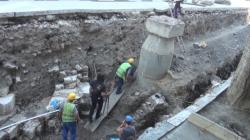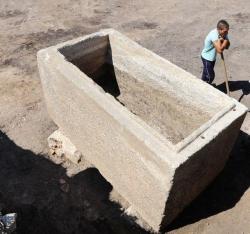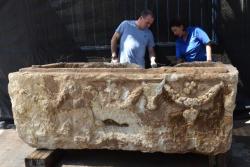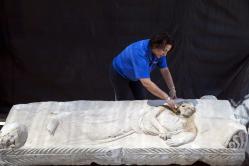INSTITUT SUPERIEUR D'ANTHROPOLOGIE
INSTITUTE OF ANTHROPOLOGY
ONLINE COURSES / COURS A DISTANCE
FALL TERM : OCTOBER 2015
REGISTER NOW
BULGARIE –  Silistra - Excavations works on the new sewage system in Silistra unveiled what specialists believe will turn out to be one of the five most important temples for the Bulgarian archaeology. The remains of the medieval church were discovered during the construction of the new water purification system, private bTV stations informs. A quarter of a century ago, archaeologists discovered episcopal patriarchal basilica on the banks of the Danube river possessing all the attributes characteristic of a cathedral temple. None of the specialists expected that another patriarchal church can be located ninety metres away from the first one. Both of the churces date back to the time of the First Bulgarian Empire. According to the archaeologist from the Regional Historical Museum in Silistra, Georgi Atanasov, the two churches functioned jointly for a long period of time. The practice of episcopal centres to have two temples is known from the times of early Christianity. Thirty graves have also been uncovered at the site, which will shed further light on the discovery. The ratio between children and adults found in the graves was 50:50, which hinted of high child mortality at the time. Atanasov assured that the ruins were not those of an ordinary town church, but rather the mother-temple of the Bulgarian patriachate, where the throne of the first Bulgarian patriarchs was located. After carrying out careful explorations, the newly discovered temple will be conserved and covered in anticipation of future specialists and solid funding.
Silistra - Excavations works on the new sewage system in Silistra unveiled what specialists believe will turn out to be one of the five most important temples for the Bulgarian archaeology. The remains of the medieval church were discovered during the construction of the new water purification system, private bTV stations informs. A quarter of a century ago, archaeologists discovered episcopal patriarchal basilica on the banks of the Danube river possessing all the attributes characteristic of a cathedral temple. None of the specialists expected that another patriarchal church can be located ninety metres away from the first one. Both of the churces date back to the time of the First Bulgarian Empire. According to the archaeologist from the Regional Historical Museum in Silistra, Georgi Atanasov, the two churches functioned jointly for a long period of time. The practice of episcopal centres to have two temples is known from the times of early Christianity. Thirty graves have also been uncovered at the site, which will shed further light on the discovery. The ratio between children and adults found in the graves was 50:50, which hinted of high child mortality at the time. Atanasov assured that the ruins were not those of an ordinary town church, but rather the mother-temple of the Bulgarian patriachate, where the throne of the first Bulgarian patriarchs was located. After carrying out careful explorations, the newly discovered temple will be conserved and covered in anticipation of future specialists and solid funding.
http://www.novinite.com/articles/170661/Excavations+Unveil+One+of+Five+Most+Important+Temples+for+Bulgarian+Archaeology
BULGARIE –  Boyanovo - A massive marble sarcophagus of a rich Ancient Thracian aristocrat has been unearthed in a Thraciantumulus (burial mound) from the period of the Roman Empire by archaeologist Daniela Agre and her team during rescue excavations near the town of Boyanovo, Elhovo Municipality, in Southeast Bulgaria. The impressive Ancient Thracian sarcophagus weighs an estimated 6 metric tons; it is 2.7 meters long, 1.4 meters wide, and its walls are 15 cm thick, reports local news site ElhovoNews. The sarcophagus, however, is not the only discovery in the excavated Thracian mound where thearchaeologists have also found a colonnade and a second tomb of brick masonry with murals. The sarcophagus has been unearthed in an Ancient Thracian burial mound near Boyanovo in a tombdating to the beginning of the 3rd century AD, the period when Ancient Thrace was already a provinceof the Roman Empire. (Rome conquered all of Ancient Thrace south of the Danube in 46 AD, with the Thracian aristocracy generally becoming absorbed as Roman provincial aristocracy.)
Boyanovo - A massive marble sarcophagus of a rich Ancient Thracian aristocrat has been unearthed in a Thraciantumulus (burial mound) from the period of the Roman Empire by archaeologist Daniela Agre and her team during rescue excavations near the town of Boyanovo, Elhovo Municipality, in Southeast Bulgaria. The impressive Ancient Thracian sarcophagus weighs an estimated 6 metric tons; it is 2.7 meters long, 1.4 meters wide, and its walls are 15 cm thick, reports local news site ElhovoNews. The sarcophagus, however, is not the only discovery in the excavated Thracian mound where thearchaeologists have also found a colonnade and a second tomb of brick masonry with murals. The sarcophagus has been unearthed in an Ancient Thracian burial mound near Boyanovo in a tombdating to the beginning of the 3rd century AD, the period when Ancient Thrace was already a provinceof the Roman Empire. (Rome conquered all of Ancient Thrace south of the Danube in 46 AD, with the Thracian aristocracy generally becoming absorbed as Roman provincial aristocracy.)
http://archaeologyinbulgaria.com/2015/08/31/archaeologists-unearth-marble-sarcophagus-tomb-with-murals-in-raided-ancient-thracian-mound-from-roman-period-in-bulgarias-boyanovo/
ISRAEL – 
 Beit Shemesh - Israel has unveiled an 1,800-year-old sarcophagus that workers found at a building site and initially tried to conceal. The two-ton limestone coffin features a life-size carving of a human figure wearing a toga on the lid and designs around the sides, including a Medusa head. Archaeologist Gaby Mazor says the piece dates back to the 3rd century and was likely commissioned by a wealthy Roman family. The sarcophagus "is decorated with, among other things, wreaths and images of bulls' heads, naked cupids, and the head of the monstrous female figure Medusa, which includes remains of hair together with snakes - part of a commonly held belief in the Roman period that she protects the deceased," Mazor said, according to The Jerusalem Post. Mazor said such sarcophagi were usually placed in, or next to, a family mausoleum. Antiquities Authority Spokeswoman Yoli Shwartz said the sarcophagus was damaged when workers unearthed it at a construction site
Beit Shemesh - Israel has unveiled an 1,800-year-old sarcophagus that workers found at a building site and initially tried to conceal. The two-ton limestone coffin features a life-size carving of a human figure wearing a toga on the lid and designs around the sides, including a Medusa head. Archaeologist Gaby Mazor says the piece dates back to the 3rd century and was likely commissioned by a wealthy Roman family. The sarcophagus "is decorated with, among other things, wreaths and images of bulls' heads, naked cupids, and the head of the monstrous female figure Medusa, which includes remains of hair together with snakes - part of a commonly held belief in the Roman period that she protects the deceased," Mazor said, according to The Jerusalem Post. Mazor said such sarcophagi were usually placed in, or next to, a family mausoleum. Antiquities Authority Spokeswoman Yoli Shwartz said the sarcophagus was damaged when workers unearthed it at a construction site
http://www.cbsnews.com/news/ancient-coffin-discovered-in-israel/?